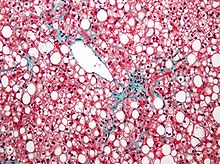- Obesity-associated morbidity
-
 Gynecomastia as seen in an obese male.
Gynecomastia as seen in an obese male.
Whether obesity should be considered a disease on its own, it is also an important risk factor for many chronic physical and mental illnesses.[1]
Contents
Cardiology
Ischemic heart disease
Obesity is associated with cardiovascular diseases including angina and myocardial infarction.[2][3] A 2002 report concluded that 21% of ischemic heart disease is due to obesity[1] while a 2008 European consensus puts the number at 35%.[4]
Congestive heart failure
Having a BMI of greater than 30 increases ones risk of heart failure by two.[5][6]
High blood pressure
More than 85% of hypertension occurs in people with a BMI of greater than 25.[6] The risk of hypertension is 5 times higher in the obese as compared to those of normal weight. A definitive link between obesity and hypertension has been found using animal and clinical studies, from these it has been realized that many mechanisms are potential causes of obesity induced hypertension. These mechanisms include the activation of the sympathetic nervous system as well as the activation of the renin–angiotensin-aldosterone system.[7]
Abnormal cholesterol levels
Obesity is associated with an increased LDL cholesterol and a lowered HDL cholesterol.[6][8]
Deep vein thrombosis and Pulmonary embolism
Obesity increases one's risk of venous thromboembolism by 2.3 fold.[9][10]
Dermatology
- stretch marks [11]
- acanthosis nigricans [11]
- lymphedema [11]
- cellulitis [11]
- hirsutism [11]
- intertrigo [12]
Endocrinology and reproductive medicine
Diabetes mellitus
One of the strongest links between obesity and disease is that with type 2 diabetes. These two conditions are so strongly linked that researches in the 1970s started calling it “diabesity”.[6] Excess weight is behind 64% of cases of diabetes in men and 77% of cases in women.[13]
Polycystic ovarian syndrome (PCOS)
Due to its association with insulin resistance, the risk of PCOS increases with adiposity. In the US approximately 60% of patients with PCOS have a BMI of greater than 30.[14]
Menstrual disorders
Infertility
Obesity leads to infertility in both men and women. This is primarily due to excess estrogen interfering with normal ovulation in women[6] and altering spermatogenesis in men.[15] It is believed to cause 6% of primary infertility.[6][16]
Complications of pregnancy
Obesity is related to many complications in preganacy including: haemorrhage, infection, increased hospital stays for the mother, and increased NICU requirements for the infant.[17] Obese women have more than twice the rate of C-sections compared to women of normal weight.[18] Obese women also have increased risk of preterm births and low birth weight infants.[19]
Birth defects
Those who are obese during pregnancy have a greater risk of have a child with a number of congenital malformations including: neural tube defects such as anencephaly and spina bifida, cardiovascular anomalies, including septal anomalies, cleft lip and palate, anorectal malformation, limb reduction anomalies, and hydrocephaly.[20]
Intrauterine fetal death
Gastrointestinal
Gastroesophageal reflux disease
Several studies have show that the frequency and severity of GERD symptoms are higher in those who are obese.[21][22]
Fatty liver disease
Cholelithiasis (gallstones)
Neurology
Stroke
Ischemic stroke in increased in both men and women who are obese.[6] For women with BMI of greater than 30 their risk of ischemic stroke was 1.7 times greater.[23] While men with a BMI of greater than 30 had a risk of stroke 2.0 times greater.[24]
Meralgia paresthetica
Migraines
Carpal tunnel syndrome
Dementia
Those who are obese have a rate of dementia 1.4 times greater than those of normal weight.[28]
Idiopathic intracranial hypertension
Multiple sclerosis
Women that are obese at age 18 have a greater than twofold increased risk of MS.[30]
Oncology
Many cancers occur at increased frequency in those who are overweight or obese. A study from the United Kingdom found that approximately 5% of cancer is due to excess weight.[31] These cancers include: [32]
- breast, ovarian
- esophageal, colorectal
- liver, pancreatic
- gallbladder, stomach
- endometrial, cervical
- prostate, kidney
- non-Hodgkin's lymphoma, multiple myeloma
Psychiatry
Depression
Obesity has been associated with depression.[6] The relationship is strongest in those who are more severely obese, those who are younger, and in women.[34] Suicide rate however decreases with increased BMI.[33]
Social stigmatization
In the United States young women who are overweight complete 0.3 year less school, are 20% less likely to get married, and make $6,710 less than their normal weight counterparts.[6][35]
Respirology
Obstructive sleep apnea
Obesity hypoventilation syndrome
 CPAP machine commonly used in OHS
CPAP machine commonly used in OHS
Obesity hypoventilation syndrome is defined as the combination of obesity, hypoxia during sleep, and hypercapnia during the day, resulting from hypoventilation.[37] Based on its definition it occurs only in the obese.
Chronic lung disease
Obesity is associated with a number of chronic lung diseases including: Asthma and COPD.[36] It is believed that a systemic pro-inflammatory state induced by some causes of obesity may be contributing to airway inflammation and thus leading to asthma.[38]
Complications during general anaesthesia
Rheumatology and Orthopedics
Gout
Compared to men with a BMI of 21 - 23, men with a BMI of 30 - 35 have 2.3 times more gout and men with a BMI of greater than 35 have 3.0 times more gout. Weight loss decreases these risks.[40]
Poor mobility
There is a strong association between obesity and musculoskeletal pain and disability[41]
Osteoarthritis
Increased rates of arthritis are seen in both weight bearing and non weight bearing joint.[6] Those with a BMI greater than 26.4 had rate of osteoarthritis of the knees 6 times greater than those with a BMI of less than 23.4, well rates of osteoarthritis in the hand was about 1.5 times greater.[42]
Low back pain
Obese individuals are twice to four times more likely to have lower back pain than their normal weight peers.[43]
Urology and Nephrology
Erectile dysfunction
One third of obese men with erectile dysfunction who lose weight have improvement in their sexual functioning.[44]
Urinary incontinence
Urge, stress, and mixed incontinence all occur at higher rates in the obese.[45] The rates are about double that found in the normal weight population.[46] Urinary incontinence improves with weight lose.[47]
Chronic renal failure
Obesity increases ones risk of renal failure by three to four times.[48]
Hypogonadism
References
- ^ a b "www.who.int" (PDF). WHO. http://www.who.int/dietphysicalactivity/media/en/gsfs_obesity.pdf. Retrieved February 22, 2009.
- ^ Poirier P, Giles TD, Bray GA, et al. (May 2006). "Obesity and cardiovascular disease: pathophysiology, evaluation, and effect of weight loss". Arterioscler. Thromb. Vasc. Biol. 26 (5): 968–76. doi:10.1161/01.ATV.0000216787.85457.f3. PMID 16627822.
- ^ Yusuf S, Hawken S, Ounpuu S, et al. (2004). "Effect of potentially modifiable risk factors associated with myocardial infarction in 52 countries (the INTERHEART study): case-control study". Lancet 364 (9438): 937–52. doi:10.1016/S0140-6736(04)17018-9. PMID 15364185.
- ^ "www.dsaf.dk". http://www.dsaf.dk/EASO%20guidelines%202008.pdf.
- ^ Kenchaiah S, Evans JC, Levy D, et al. (August 2002). "Obesity and the risk of heart failure". N. Engl. J. Med. 347 (5): 305–13. doi:10.1056/NEJMoa020245. PMID 12151467.
- ^ a b c d e f g h i j k l m n o Haslam DW, James WP (October 2005). "Obesity". Lancet 366 (9492): 1197–209. doi:10.1016/S0140-6736(05)67483-1. PMID 16198769.
- ^ Rahmouni K, Correia ML, Haynes WG, Mark AL (January 2005). "Obesity-associated hypertension: new insights into mechanisms". Hypertension 45 (1): 9–14. doi:10.1161/01.HYP.0000151325.83008.b4. PMID 15583075.
- ^ Grundy SM, Barnett JP (December 1990). "Metabolic and health complications of obesity". Dis Mon 36 (12): 641–731. PMID 2261844.
- ^ Ageno W, Becattini C, Brighton T, Selby R, Kamphuisen PW (January 2008). "Cardiovascular risk factors and venous thromboembolism: a meta-analysis". Circulation 117 (1): 93–102. doi:10.1161/CIRCULATIONAHA.107.709204. PMID 18086925.
- ^ Darvall KA, Sam RC, Silverman SH, Bradbury AW, Adam DJ (February 2007). "Obesity and thrombosis". Eur J Vasc Endovasc Surg 33 (2): 223–33. doi:10.1016/j.ejvs.2006.10.006. PMID 17185009.
- ^ a b c d e Yosipovitch G, DeVore A, Dawn A (June 2007). "Obesity and the skin: skin physiology and skin manifestations of obesity". J. Am. Acad. Dermatol. 56 (6): 901–16; quiz 917–20. doi:10.1016/j.jaad.2006.12.004. PMID 17504714.
- ^ Hahler B (June 2006). "An overview of dermatological conditions commonly associated with the obese patient". Ostomy Wound Manage 52 (6): 34–6, 38, 40 passim. PMID 16799182.
- ^ Peter G. Kopelman, Ian D. Caterson, Michael J. Stock, William H. Dietz (2005). Clinical obesity in adults and children: In Adults and Children. Blackwell Publishing. pp. 493. ISBN 140-511672-2. http://books.google.ca/books?id=u7RvldSr5M0C.
- ^ Azziz R, Sanchez LA, Knochenhauer ES, et al. (February 2004). "Androgen excess in women: experience with over 1000 consecutive patients". J. Clin. Endocrinol. Metab. 89 (2): 453–62. doi:10.1210/jc.2003-031122. PMID 14764747. http://jcem.endojournals.org/cgi/pmidlookup?view=long&pmid=14764747.
- ^ Hammoud AO, Gibson M, Peterson CM, Meikle AW, Carrell DT (October 2008). "Impact of male obesity on infertility: a critical review of the current literature". Fertil. Steril. 90 (4): 897–904. doi:10.1016/j.fertnstert.2008.08.026. PMID 18929048.
- ^ a b Arendas K, Qiu Q, Gruslin A (June 2008). "Obesity in pregnancy: pre-conceptional to postpartum consequences". J Obstet Gynaecol Can 30 (6): 477–88. PMID 18611299.
- ^ Heslehurst N, Simpson H, Ells LJ, et al. (November 2008). "The impact of maternal BMI status on pregnancy outcomes with immediate short-term obstetric resource implications: a meta-analysis". Obes Rev 9 (6): 635–83. doi:10.1111/j.1467-789X.2008.00511.x. PMID 18673307.
- ^ Poobalan AS, Aucott LS, Gurung T, Smith WC, Bhattacharya S (January 2009). "Obesity as an independent risk factor for elective and emergency caesarean delivery in nulliparous women--systematic review and meta-analysis of cohort studies". Obes Rev 10 (1): 28–35. doi:10.1111/j.1467-789X.2008.00537.x. PMID 19021871.
- ^ "Overweight and obesity in mothers and risk of preterm birth and low birth weight infants: systematic review and meta-analyses -- McDonald et al. 341: c3428 -- BMJ". http://www.bmj.com/cgi/content/full/341/jul20_1/c3428.
- ^ Stothard KJ, Tennant PW, Bell R, Rankin J (February 2009). "Maternal overweight and obesity and the risk of congenital anomalies: a systematic review and meta-analysis". JAMA 301 (6): 636–50. doi:10.1001/jama.2009.113. PMID 19211471.
- ^ Anand G, Katz PO (2008). "Gastroesophageal reflux disease and obesity". Rev Gastroenterol Disord 8 (4): 233–9. PMID 19107097. http://www.medreviews.com/pubmed.cfm?j=3&v=8&i=4&p=233.
- ^ pmid 19475461
- ^ Kurth T, Gaziano JM, Rexrode KM, et al. (April 2005). "Prospective study of body mass index and risk of stroke in apparently healthy women". Circulation 111 (15): 1992–8. doi:10.1161/01.CIR.0000161822.83163.B6. PMID 15837954.
- ^ Kurth T, Gaziano JM, Berger K, et al. (2002). "Body mass index and the risk of stroke in men". Arch. Intern. Med. 162 (22): 2557–62. doi:10.1001/archinte.162.22.2557. PMID 12456227. http://archinte.ama-assn.org/cgi/pmidlookup?view=long&pmid=12456227.
- ^ Harney D, Patijn J (2007). "Meralgia paresthetica: diagnosis and management strategies". Pain Med 8 (8): 669–77. doi:10.1111/j.1526-4637.2006.00227.x. PMID 18028045.
- ^ Bigal ME, Lipton RB (January 2008). "Obesity and chronic daily headache". Curr Pain Headache Rep 12 (1): 56–61. doi:10.1007/s11916-008-0011-8. PMID 18417025.
- ^ Sharifi-Mollayousefi A, Yazdchi-Marandi M, Ayramlou H, et al. (February 2008). "Assessment of body mass index and hand anthropometric measurements as independent risk factors for carpal tunnel syndrome". Folia Morphol. (Warsz) 67 (1): 36–42. PMID 18335412.
- ^ Beydoun MA, Beydoun HA, Wang Y (May 2008). "Obesity and central obesity as risk factors for incident dementia and its subtypes: A systematic review and meta-analysis". Obes Rev 9 (3): 204–18. doi:10.1111/j.1467-789X.2008.00473.x. PMID 18331422.
- ^ Wall M (March 2008). "Idiopathic intracranial hypertension (pseudotumor cerebri)". Curr Neurol Neurosci Rep 8 (2): 87–93. doi:10.1007/s11910-008-0015-0. PMID 18460275.
- ^ Munger KL, Chitnis T, Ascherio A. (2009). "Body size and risk of MS in two cohorts of US women". Neurology 73 (19): 1543–50. doi:10.1212/WNL.0b013e3181c0d6e0. PMC 2777074. PMID 19901245. http://www.pubmedcentral.nih.gov/articlerender.fcgi?tool=pmcentrez&artid=2777074.
- ^ Reeves GK, Pirie K, Beral V, Green J, Spencer E, Bull D (December 2007). "Cancer incidence and mortality in relation to body mass index in the Million Women Study: cohort study". BMJ 335 (7630): 1134. doi:10.1136/bmj.39367.495995.AE. PMC 2099519. PMID 17986716. http://www.pubmedcentral.nih.gov/articlerender.fcgi?tool=pmcentrez&artid=2099519.
- ^ Calle EE, Rodriguez C, Walker-Thurmond K, Thun MJ (April 2003). "Overweight, obesity, and mortality from cancer in a prospectively studied cohort of U.S. adults". N. Engl. J. Med. 348 (17): 1625–38. doi:10.1056/NEJMoa021423. PMID 12711737.
- ^ a b Mukamal KJ, Rimm EB, Kawachi I, O'Reilly EJ, Calle EE, Miller M (November 2009). "Body Mass Index and Risk of Suicide Among One Million US Adults". Epidemiology 21 (1): 82–6. doi:10.1097/EDE.0b013e3181c1fa2d. PMID 19907331.
- ^ Dixon JB, Dixon ME, O'Brien PE (September 2003). "Depression in association with severe obesity: changes with weight loss". Arch. Intern. Med. 163 (17): 2058–65. doi:10.1001/archinte.163.17.2058. PMID 14504119.
- ^ Gortmaker SL, Must A, Perrin JM, Sobol AM, Dietz WH (September 1993). "Social and economic consequences of overweight in adolescence and young adulthood". N. Engl. J. Med. 329 (14): 1008–12. doi:10.1056/NEJM199309303291406. PMID 8366901. http://content.nejm.org/cgi/pmidlookup?view=short&pmid=8366901&promo=ONFLNS19.
- ^ a b Poulain M, Doucet M, Major GC, et al. (April 2006). "The effect of obesity on chronic respiratory diseases: pathophysiology and therapeutic strategies". CMAJ 174 (9): 1293–9. doi:10.1503/cmaj.051299. PMC 1435949. PMID 16636330. http://www.cmaj.ca/cgi/content/full/174/9/1293.
- ^ Anonymous (1999). "Sleep-related breathing disorders in adults: recommendations for syndrome definition and measurement techniques in clinical research. The Report of an American Academy of Sleep Medicine Task Force". Sleep 22 (5): 667–89. PMID 10450601.
- ^ Sutherland ER (August 2008). "Obesity and asthma". Immunol Allergy Clin North Am 28 (3): 589–602, ix. doi:10.1016/j.iac.2008.03.003. PMC 2504765. PMID 18572109. http://www.pubmedcentral.nih.gov/articlerender.fcgi?tool=pmcentrez&artid=2504765.
- ^ Adams JP, Murphy PG (July 2000). "Obesity in anaesthesia and intensive care". Br J Anaesth 85 (1): 91–108. doi:10.1093/bja/85.1.91. PMID 10927998. http://bja.oxfordjournals.org/cgi/pmidlookup?view=long&pmid=10927998.
- ^ Choi HK, Atkinson K, Karlson EW, Curhan G (April 2005). "Obesity, weight change, hypertension, diuretic use, and risk of gout in men: the health professionals follow-up study". Arch. Intern. Med. 165 (7): 742–8. doi:10.1001/archinte.165.7.742. PMID 15824292.
- ^ Tukker A, Visscher T, Picavet H (April 2008). "Overweight and health problems of the lower extremities: osteoarthritis, pain and disability". Public Health Nutr 12 (3): 1–10. doi:10.1017/S1368980008002103. PMID 18426630.
- ^ Hart DJ, Spector TD (February 1993). "The relationship of obesity, fat distribution and osteoarthritis in women in the general population: the Chingford Study". J. Rheumatol. 20 (2): 331–5. PMID 8474072.
- ^ Molenaar EA, Numans ME, van Ameijden EJ, Grobbee DE (November 2008). "[Considerable comorbidity in overweight adults: results from the Utrecht Health Project]" (in Dutch; Flemish). Ned Tijdschr Geneeskd 152 (45): 2457–63. PMID 19051798.
- ^ Esposito K, Giugliano F, Di Palo C, Giugliano G, Marfella R, D'Andrea F, D'Armiento M, Giugliano D (2004). "Effect of lifestyle changes on erectile dysfunction in obese men: A randomized controlled trial". JAMA 291 (24): 2978–84. doi:10.1001/jama.291.24.2978. PMID 15213209.
- ^ Hunskaar S (2008). "A systematic review of overweight and obesity as risk factors and targets for clinical intervention for urinary incontinence in women". Neurourol. Urodyn. 27 (8): 749–57. doi:10.1002/nau.20635. PMID 18951445.
- ^ Bart S, Ciangura C, Thibault F, et al. (September 2008). "[Stress urinary incontinence and obesity]" (in French). Prog. Urol. 18 (8): 493–8. doi:10.1016/j.purol.2008.04.015. PMID 18760738.
- ^ "NEJM -- Weight Loss to Treat Urinary Incontinence in Overweight and Obese Women". http://content.nejm.org/cgi/content/short/360/5/481.
- ^ Ejerblad E, Fored CM, Lindblad P, Fryzek J, McLaughlin JK, Nyrén O (2006). "Obesity and risk for chronic renal failure". J. Am. Soc. Nephrol. 17 (6): 1695–702. doi:10.1681/ASN.2005060638. PMID 16641153.
- ^ Makhsida N, Shah J, Yan G, Fisch H, Shabsigh R (September 2005). "Hypogonadism and metabolic syndrome: Implications for testosterone therapy". J. Urol. 174 (3): 827–34. doi:10.1097/01.ju.0000169490.78443.59. PMID 16093964.
Categories:
Wikimedia Foundation. 2010.



